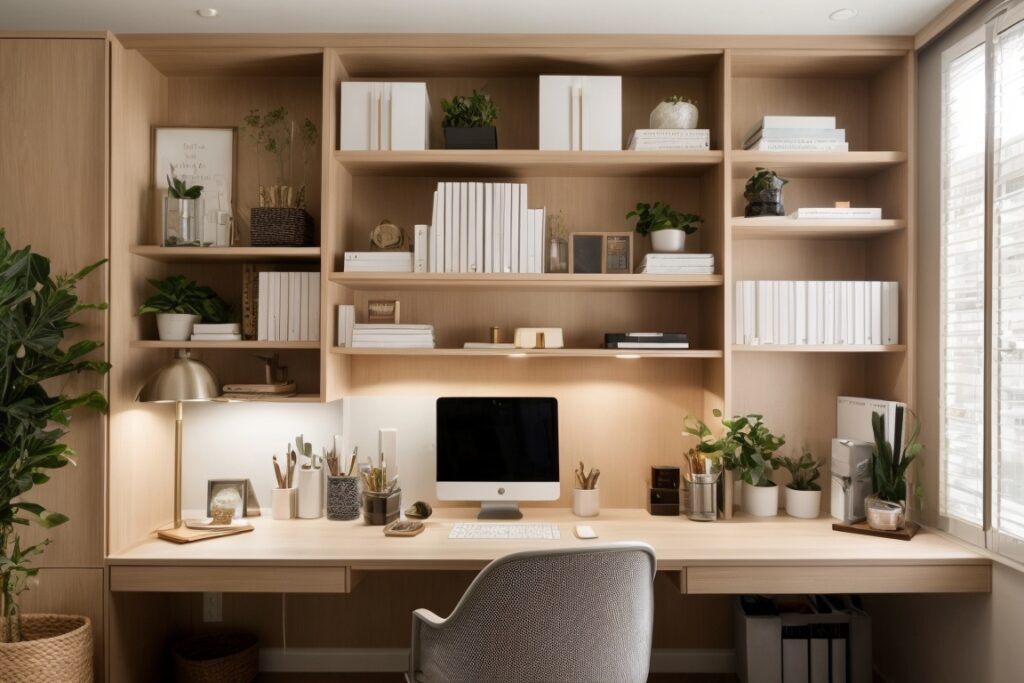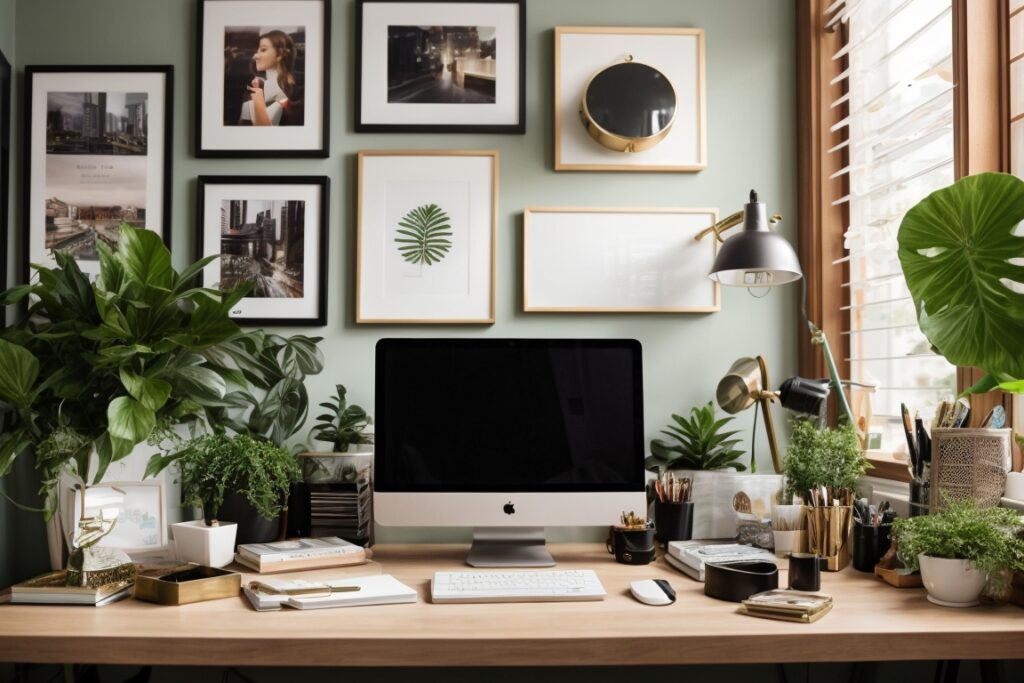In the realm of remote work and home offices, desk organization is not merely a matter of aesthetics; it’s the cornerstone of productivity and efficiency. A cluttered desk can be a constant source of distraction, hindering focus and creativity. Conversely, a well-organized workspace promotes clarity, minimizes time spent searching for misplaced items, and fosters a sense of calm and control.
Establishing an organized home office desk is a journey, not a destination. It requires an initial decluttering purge, followed by the implementation of thoughtful storage solutions and organizational strategies. The process also demands ongoing maintenance, as new items accumulate and work habits evolve.
10 Home Office Desk Organization Ideas:-
1. Declutter and Purge: A Clean Slate for Organization

The path to desk organization begins with a ruthless decluttering and purging exercise. This involves scrutinizing every item on the desk and asking a simple question: does it serve a purpose or is it merely clutter? Be ruthless in your assessment, removing items that are no longer needed, have no immediate use, or are simply distractions.
Start by discarding obvious trash items, such as empty coffee cups, used pens, and crumpled notes. Then, tackle the more challenging decisions: which documents can be scanned and stored digitally? Which books can be returned to the library or donated? Which gadgets are duplicates or no longer used?
As you declutter, consider the purpose of your workspace. What are your primary tasks? What items do you use most frequently? Prioritize these items and keep them within easy reach. Relegate less frequently used items to drawers, shelves, or vertical organizers.
2. Designate Zones for Different Functions: A Workspace with Intention

An organized desk is not just about clearing clutter; it’s about creating a workspace that supports your specific workflow. By designating zones for different functions, you can enhance efficiency and minimize distractions.
Imagine your desk as a miniature office, with dedicated areas for different tasks. Establish a ‘writing zone’ for focused work, equipped with notebooks, pens, and any necessary reference materials. Create a ‘computing zone’ for digital tasks, with clear space for your laptop or desktop monitor. If you frequently engage in video conferencing, designate a ‘communication zone’ with optimal lighting and a clear background.
Visual cues can help reinforce these zones. Use desk dividers, trays, or even different surface materials to demarcate the areas. This visual separation will help you mentally transition between tasks, promoting focus and productivity.
3. Utilize Storage Solutions: Maximizing Space and Maintaining Order

With clutter purged and zones designated, it’s time to harness the power of storage solutions. The right storage options can transform your desk from a chaotic mess into a haven of organization.
Drawers are an essential component of any well-organized desk. Use drawers to store frequently used items, such as pens, pencils, paper clips, and stationery. Label each drawer clearly to ensure easy retrieval. For larger items, consider using drawer dividers to further compartmentalize and maximize space.
Shelves and cabinets provide additional storage capacity, especially for items that are not used daily but still need to be readily accessible. Install shelves or cabinets above or around your desk to utilize vertical space effectively. Use clear containers or dividers to keep items organized and visible.
Pegboards offers a versatile and customizable storage solution. Hang pegboards on the wall above your desk to store tools, stationery, and other frequently used items. Use hooks, clips, and shelves to create a personalized storage system that suits your needs.
Remember, the key to effective storage lies in selecting the right containers and organizing them thoughtfully. Choose containers that are the appropriate size for the items they’ll hold, and label them clearly to avoid confusion. To make it easier to locate comparable things, group them together.
By utilizing a combination of drawers, shelves, cabinets, and pegboards, you can create a desk organization system that maximizes space, maintains order, and supports your unique workflow.
4. Tame the Tangled Wires: A Clutter-Free Workspace for Clarity and Safety

Tangled wires are the bane of many home office desks, creating an unsightly mess and posing potential safety hazards. Untangling and organizing your wires can significantly improve the aesthetics and functionality of your workspace.
Start by identifying the source of the tangled mess. Are there multiple power strips or adapters creating a jumble of cords? Are cables running haphazardly across the desk, under chairs, and around other equipment? Once you’ve identified the problem areas, take action to tame the unruly wires.
Invest in cable ties, clips, and cord management systems. These tools can be used to bundle wires together, secure them to the underside of your desk, and create a neat and organized arrangement. Label each cable clearly to make it easier to identify and troubleshoot any issues.
Consider using cable sleeves or conduits to hide wires completely, creating a clean and polished look. These sleeves can be easily attached to the underside of your desk or along walls to conceal the clutter.
Remember, proper wire management is not just about aesthetics; it’s also about safety. Exposed wires can pose a tripping hazard and increase the risk of electrical shocks. By organizing your wires, you can reduce these risks and create a safer, more comfortable workspace.
5. Embrace Vertical Space: Expanding Storage Capacity and Maximizing Efficiency

In the limited confines of a home office, vertical space often goes underutilized. By embracing vertical space, you can significantly expand your storage capacity and maximize desk efficiency.
Look for opportunities to install shelves, cabinets, or hanging organizers on walls above or around your desk. These vertical storage solutions can accommodate books, documents, office supplies, and other items that would otherwise clutter your desk surface.
Consider using wall-mounted organizers or pegboards to create a designated space for tools, stationery, and other frequently used items. These organizers can be customized to suit your specific needs and preferences.
When utilizing vertical space, prioritize items that are used less frequently but still need to be readily accessible. Place items that are used daily within easy reach on your desk surface.
By embracing vertical space, you can transform your home office from a cramped and cluttered environment into an organized and efficient workspace.
6. Embrace Digital Organization: Complementing Physical Organization and Enhancing Productivity

In today’s digital age, physical desk organization goes hand-in-hand with digital organization. By streamlining your digital files, tasks, and schedules, you can complement your physical workspace organization and enhance productivity.
Start by implementing a digital file management system. Create folders and subfolders to categorize your documents, images, and other digital files. Use consistent naming conventions for easy retrieval. Utilize cloud storage services to back up your files securely and access them from anywhere.
Embrace digital tools for managing tasks and schedules. Project management software, to-do list apps, and digital calendars can help you stay organized, prioritize tasks, and meet deadlines. Consider using time-tracking tools to gain insights into your work habits and identify areas for improvement.
Leverage digital communication tools to stay connected with colleagues and clients. Email, instant messaging platforms, and video conferencing tools can facilitate efficient communication and collaboration.
Remember, the key to effective digital organization lies in choosing the right tools and using them consistently. Avoid oversaturating yourself with too many tools. Instead, select a few essential tools that align with your workflow and utilize them effectively.
By embracing digital organization, you can streamline your work processes, enhance collaboration, and maximize productivity, complementing your physical desk organization efforts.
7. Personalize Your Workspace: Creating a Motivating and Inspiring Environment

While organization is essential, a well-designed home office should also be a reflection of your personality and preferences. Incorporating personal touches can create a motivating and inspiring environment that fosters creativity and productivity.
Add elements of décor that inspire you and reflect your interests. A framed piece of artwork, a collection of books by your favorite authors, or a plant or two can add a touch of personality and make your workspace feel more inviting.
Personalize your tools and stationery. Use pens, notebooks, and other accessories in colors and styles that you find appealing. A personalized workspace can boost your mood and increase your motivation.
Consider incorporating ergonomic elements to promote comfort and well-being. A supportive chair, an adjustable desk stand, and a well-positioned monitor can help prevent fatigue and discomfort, allowing you to focus on your work.
Remember, the goal is to create a workspace that is both functional and inspiring. Personalize your home office in a way that reflects your unique style and enhances your productivity.
8. Establish a Daily Routine: Maintaining Organization and Preventing Clutter Buildup

A well-organized desk is not just a one-time achievement; it requires ongoing maintenance. Establishing a daily routine for tidying up your workspace can prevent clutter buildup and maintain a sense of order.
Dedicate a few minutes at the end of each workday to put things back in their designated places. Clear away papers, organize your tools, and straighten up any cords or cables. This simple act of tidying up can make a world of difference in maintaining a clutter-free workspace.
Develop a system for handling incoming paperwork. Sort mail immediately, discarding junk mail, and filing or scanning important documents. Create a designated space for incoming tasks or projects to avoid them piling up on your desk.
Regularly review your storage areas and declutter as needed. Remove unused items, consolidate similar items, and discard anything that is no longer relevant or useful.
By establishing a daily routine and practicing regular maintenance, you can prevent clutter from taking over your home office desk and maintain a well-organized workspace that supports your productivity and well-being.
9. Embrace Technology: Enhancing Organization and Productivity with Digital Solutions

Technology plays an increasingly important role in enhancing desk organization and boosting productivity. By embracing the right digital solutions, you can streamline your workflow, optimize your workspace, and achieve new levels of efficiency.
Leverage productivity apps and tools. A plethora of productivity apps can help you manage tasks, schedules, notes, and projects effectively. Explore options like to-do list apps, project management software, and note-taking tools to find the ones that best suit your needs.
Utilize cloud storage services. Cloud storage platforms offer secure and accessible storage for your files, documents, and other digital assets. This eliminates the need for physical clutter and allows you to access your files from anywhere.
Embrace document scanning and management. Invest in a document scanner to digitize paper documents, reducing clutter and creating easily searchable digital copies. Utilize document management software to organize and manage your digital files efficiently.
Explore smart home integration. Consider integrating smart home technology into your workspace to enhance convenience and organization. Smart lighting can adjust automatically based on your preferences, while smart speakers can control music, set reminders, and manage your schedule hands-free.
Remember, the key to embracing technology effectively is to select tools that align with your workflow and preferences. Avoid oversaturating yourself with too many apps or gadgets. Instead, focus on a few essential tools that can make a significant impact on your organization and productivity.
10. Seek Inspiration and Adapt: Continuously Optimizing Your Organized Workspace

The journey to an organized home office desk is an ongoing process, requiring continuous adaptation and improvement. Seek inspiration from other organized workspaces, both online and in real life. Explore blogs, social media accounts, and magazines dedicated to workspace organization to gather ideas and discover new strategies.
Adapt your organizational methods as your work habits and needs evolve. As your workload changes or new projects arise, revisit your storage solutions, digital tools, and daily routines to ensure they continue to support your productivity.
Embrace flexibility and adaptability in your approach to organization. There is no one-size-fits-all solution. Experiment with different strategies, find what works best for you, and continuously refine your approach.
Remember, an organized desk is not just about aesthetics; it’s about creating a workspace that supports your productivity, well-being, and creativity. By seeking inspiration, adapting to your needs, and embracing technology, you can transform your home office into a hub of efficiency and inspiration.
Conclusion: Cultivating an Organized and Inspiring Home Office
Creating an organized home office is not an overnight project; it’s a journey of continuous refinement and adaptation. By implementing the strategies outlined in this guide, you can transform your workspace into a hub of efficiency, inspiration, and well-being.
Remember, the key to success lies in tailoring your organizational approach to your specific needs, preferences, and workflow. Embrace flexibility, seek inspiration, and adapt your strategies as your work habits evolve.
With dedication and a touch of creativity, you can cultivate an organized home office that empowers you to achieve your goals, unleash your creativity, and experience the true joy of productive work.







